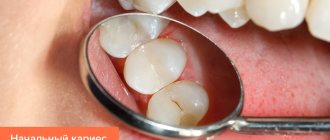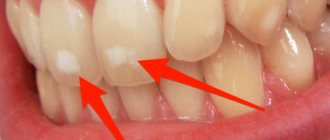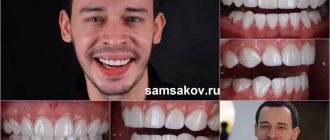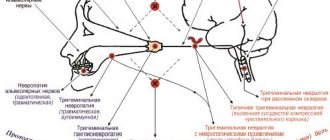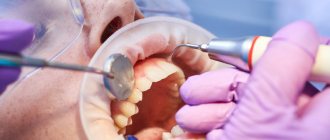When communicating with some people, it is impossible not to pay attention to the strange, unnatural and sometimes even frightening color of teeth. Sometimes a yellowish or grayish tint appears on them. It happens that brown spots appear directly on the teeth. All this, as a rule, indicates so-called pigmentation. How does it manifest itself, where does it come from and how to deal with it? These are, perhaps, the main questions that concern people who have encountered similar phenomena. In order to understand how to deal with such a problem, we must penetrate into its essence, find out for ourselves what are the known causes of tooth pigmentation.
External pigmentation on teeth
Among dentists, causes are usually divided into external and internal. Let's start, perhaps, with external factors. These usually include those substances that we use in everyday life, which externally stain the tooth, penetrating into the pores of its enamel.
The most dangerous factor can be called smoking, because the nicotine resins contained in tobacco give the enamel an unpleasant yellowish-brown tint. A similar substance in its effects is coffee. It is also impossible not to mention strong black tea and red wine. They also play an important role in destroying tooth enamel and giving it an unaesthetic appearance.
We must not forget about the huge number of food dyes, in which the coloring pigments cause damage. And, of course, one cannot fail to mention the stones and plaque that arise due to violation of oral hygiene rules, lack of minerals in the body and a minimal amount of solid food or even its absence in the diet. External manifestations of pigmentation on teeth are not difficult to eliminate. All you need is advice from a dentist. You will also need to use the right toothpaste.
Classification of tooth pigmentation
Types of pigmentation are divided into two groups:
- Endogenous pigmentation that occurs in a newborn. If he is diagnosed with hemolytic disease. Or if the mother took a tetracycline antibiotic.
- Exogenous pigmentation appears as a result of food and medicinal dyes or when a tooth is injured.
Internal pigmentation
The situation is much more complicated with internal pigmentation, because then the internal hard tissue of the tooth is already stained. There can be a huge number of reasons for such changes in the oral cavity. One of the most common is a change in the balance of fluoride in the body. Why? Fluoride has a destructive effect on teeth, since the tissue changes its color depending on its lack or excess.
Stories are replete with cases where all the villagers had the same stains on their teeth because all the villagers drank water from the same underground springs. In some cases, staining of tooth enamel occurs due to the use of tetracycline antibiotics. It also happens that the cause of such a problem can be a filling placed as a result of dental surgery, provided that the material was made of copper amalgam.
For some, pigmentation comes with age. Hereditary factors also play a role. In children, pigmentation on the teeth can also be due to an improper diet and a sharp change in temperature in the oral cavity, for example, when consuming cold food immediately after hot food.
The feasibility of treating pigmented fissures
Unfortunately, many experts are of the opinion that pigmented fissures need to be treated. When the slightest change in color is detected, various types of intervention are resorted to, including invasive opening and filling. However, it is worth understanding that even the highest quality filling lasts no more than 5-10 years, and there is nothing more reliable than natural tooth tissue.
In fact, pigmented fissures in themselves are not an indication for treatment. They can remain in one state for life and will never become an entry point for caries. An attentive, highly qualified dentist will recommend monitoring the development of the process, tracking the slightest violations of the enamel in pigmented fissures.
Diagnostics: what methods are used in dentistry?
Science, unfortunately, has not yet made big strides in diagnosing dental pigmentation. Limitations in laboratory and clinical research, the lack of availability of high-quality and modern equipment affect the efficiency of dentists.
But, despite all the obstacles, in our country there are a huge number of specialists endowed with intelligence and experience who, after conducting only a visual examination of the patient, will be able to accurately diagnose pigmentation on the teeth. Although there are often cases when in diagnosis it is necessary to resort to modern technologies, such as radiography or orthopantomography, with the help of which the dentist studies the internal problems of damaged teeth.
Doctors have a large number of other devices and methods in their arsenal that are used in particularly difficult situations. These include, for example, microscopy or rheodentography. They allow the specialist to examine the problem in more detail. And in the study of tissues such as gums or blood vessels, a device called a reparodontograph is often used.
Diagnostic methods
The most important method for diagnosing discoloration is visual examination and collection of information about the condition of the body as a whole. To assess the internal condition of the teeth, radiography . To obtain more accurate information about structural changes in tissues, digital technologies are used. An orthopantomograph is a device that helps to view the dentition on a computer screen with high resolution from different angles. The role of this study is especially important during therapy, to monitor the correctness of the chosen course. Another highly informative method for diagnosing pigmentation is microscopy . It allows you to enlarge the object under study tens of times and examine the area of pathology extremely closely.
Is it necessary to treat such an illness?
How many people plan to treat tooth pigmentation? Most people consider the problem to be purely cosmetic. There are many reasons for such negligence on the part of patients. This includes illiteracy, arrogance, carelessness, and often, of course, fear. It always seems to the average person that now he will introduce more vegetables and dairy products into his diet, start using more expensive toothpaste, and the problem will be eliminated. But it won't work that way.
The color of the teeth will not acquire the desired snow-white shade. If such a problem arises, you should immediately contact a specialist, and the sooner you do this, the better for you. Moreover, both from the aesthetic and material side. Using special equipment, a dentist can easily rid you of external plaque on tooth enamel, identify the internal cause of pigmentation and, accordingly, prescribe a specific course of treatment in order to eliminate not only the symptoms of the disease, but also the disease itself.
Treatment of tooth pigmentation and plaque
LEVI-DENT dentistry in Lyubertsy offers the best safe and effective ways to treat tooth pigmentation and plaque:
- ultrasonic teeth cleaning – a gentle method of deep cleaning of teeth using an ultrasonic scaler;
- care using the Air Flow system – professional, gentle cleaning of teeth from plaque and deposits using a sandblasting machine;
- remineralizing therapy - a set of measures to restore the structure of teeth by artificially saturating the enamel with useful elements;
- teeth whitening ZOOM – painless whitening of a smile by 10-12 tones by applying special chemical reagents to the enamel;
- home whitening with trays – the technique involves wearing an individual tray with a mild bleaching agent.
In cases where the above procedures are contraindicated for the patient, restoration with veneers is used. Installation of microprostheses helps to hide or disguise aesthetic defects of dental units.
For pigmentation caused by systemic diseases, treatment should be comprehensive. Therapeutic therapy is aimed not only at the affected dental units, but also at the entire body. Often, in addition to dental procedures, the doctor additionally prescribes vitamins, fluoride and calcium preparations.
Colgate Simply White Night Gel
The list of common treatments is relatively small and is available to everyone. Most drugs are undesirable to use without the advice of a specialist. However, what to do when there is not always enough free time to visit the dentist, and the problem requires an immediate solution due to certain life circumstances? In such cases, you can rely on some cosmetic products, such as some toothpastes or gels.
There are an endless number of different options, but the most popular among ordinary consumers is Colgate Simply White Night gel. A group of scientists was given a task: how to whiten teeth without harming the enamel, and to do it in such a way that everyone could do it at home.
The method of application is extremely simple, as it was created from the point of view of maximum comfort.
How to use the gel?
To begin, you simply need to clean your tooth enamel using standard methods, such as a toothbrush and toothpaste. This is necessary so that there are no excess bacteria in the oral cavity and the space is ready for treatment. Then you should dry each tooth with a special swab and apply the gel to them.
It is recommended not to eat anything for 15-20 minutes. And thus, within a few days you will notice the result, and after a longer time, your smile will finally acquire that desired shine. The effect of such whitening can be observed for about one year. Then the course must be repeated.
The drug "Gluflutored"
However, not all products are as simple, effective and easy to use as the gel described above. Most drugs can be harmful if used without proper prescription from a doctor, who will instruct in detail and warn against potential risks.
The specialist will tell you how to get rid of external and internal manifestations of pigmentation, how to strengthen tooth enamel and prevent diseases. An effective way to get rid of the problem is to change the chemical composition of saliva by influencing the thyroid gland with a certain set of minerals, vitamins and fluoride for teeth. One of the most common substances used for treatment in clinical settings is Glufluored.
Pigmentation
Naturally, it was necessary to first make inlays, which were also offered to the patient from a precious alloy.
The most interesting thing is that we will not talk about crowns and inlays at all, but about the treatment of caries in teeth 14 and 17, which, of course, was present on the contact surfaces of these same 14 and 17. Could it be otherwise? My experience says that it doesn't happen. For some reason, this is not obvious to many... Those who treated teeth 15 and 16 did not diagnose caries on teeth 14 and 17. The first visit, where an acquaintance and consultation took place, was at a high level. The doctor and patient were satisfied with each other, as during the entire subsequent treatment. The treatment plan was outlined and approved by the patient. So, after a couple of days we started... Let's start!
The first step was to remove the metal pin from 14. Not that I am fundamentally against metal pins... everything has a right to exist, but only if it is done correctly, and the main thing is to have its own meaning. Removing the pin seemed absolutely necessary to me. Firstly, (based on experience) we often install pins not according to technology, but screw them directly into the root filling. But this, of course, was more of a suspicion. Alas, not groundless... Secondly, a round pin in the oval section of the canal of the 15th tooth will not fulfill its function of holding the restoration of the destroyed coronal part. Thirdly... two arguments are quite enough.
The restoration was mercilessly, but carefully, destroyed with a drill so that the pin could be “knocked out” with ultrasound. Nothing unexpected happened. The pin was in gutta-percha, the canal had an oval cross-section. The restoration made no sense from either a biological or mechanical point of view. Removing the pin was simple and short. In gutta-percha, he held on, as is understandable, rather weakly. After removing the temporary filling from 16, it turned out that the mouths of the canals were not sealed, even the gutta-percha was not removed from the mouths. But considering that the canals were filled only about seven days ago, a good x-ray picture and the patient’s active reluctance to undergo repeated endodontic treatment, it was decided to restore the teeth “as is.”
Intrigue…
After freeing the long-suffering chewing teeth 15 and 16 from all temporary and non-temporary restorations and preparing them for inlays, teeth 17 and 14 were revealed. Considering that the proximal surfaces 15 and 16 were affected (in our case, they were completely absent), it was not difficult to assume the presence of carious lesions on the medial surface 17 and the distal surface 14. The assumptions were confirmed.
"Glufluored": how is it used?
It is applied quite simply. The tooth is washed with water and dried. The substance is applied to the enamel surface and disinfected after a minute. The procedure is usually repeated about twice a year. And although glufluored is inherently harmless, it still cannot be used without careful medical supervision. Because the drug requires an extremely precise order of use, as well as applying a precisely measured amount of the composition. After this procedure, the dentist usually applies bonding to the surface of the teeth.
This drug has an official name, which sounds like Monobond Plus. It helps in restoring and strengthening the connections between the surface of the tooth and the substance applied to it. This remedy is, in principle, harmless for most people. The only exceptions may be individual allergic reactions to certain substances contained in boding. But such incidents are rare.
Online consultation with a doctor if you are concerned about symptoms
Alternative Methods
Sometimes the use of whitening procedures is contraindicated or the patient simply does not want to do it on a regular basis. In such cases, overlays are used.
- Veneers
Special veneers are made from ceramic or composite materials. They are selected to match the size of the teeth and then glued to the outer surface. Veneers are made in small rows of 5-7 pieces. Teeth under veneers, unlike crowns, remain alive. And they can be changed every 10-15 years.
- Lumineers
These linings are made from special porcelain, reinforced with nickel for strength. They are thinner than veneers, and teeth do not have to be specially prepared for them.
Dental veneers don't just change color, they rejuvenate your smile and strengthen your teeth.
The drug "Remodent"
A wonderful drug with which you can both strengthen your teeth enamel and preserve it for many years is Remodent. 70% of dentists prescribe it for preventive and therapeutic purposes. It has no side effects, with the possible exception of individual allergic reactions. It is effective and easy to use.
You will need 3 g of powder per 100 ml of boiled water at room temperature. You need to rinse your mouth after eating every few days for 10 months.
Folk remedies: what methods used by our grandmothers are effective?
It would be blasphemous not to remember folk remedies, proven by the experience of many generations. However, they should also be used in moderation, because they are extremely effective and can not only remove excess plaque, but also erase the enamel. For example, many people sometimes brush their teeth by dipping a brush in baking soda. Rubbing your teeth with hydrogen peroxide is also an equally effective remedy.
We will not deviate from ordinary products, the benefits of which were known long before us. For example, rubbing strawberries on your teeth and gums. Or you can brush your teeth with charcoal from a burnt eggplant.
